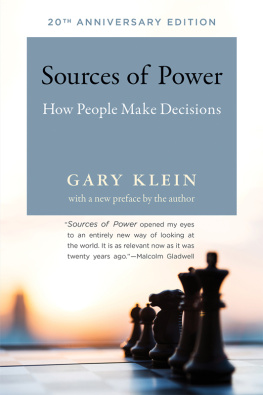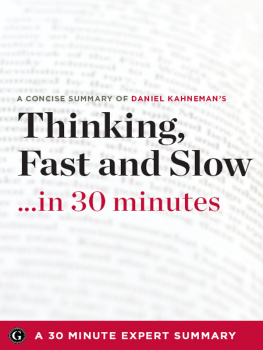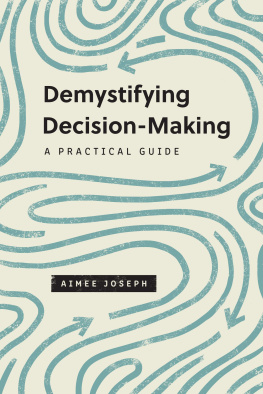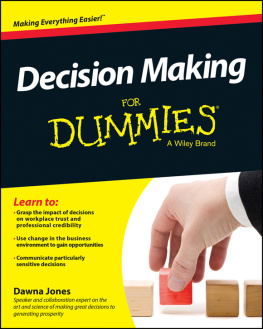
Sources of Power
How People Make Decisions
20th Anniversary Edition
Gary Klein
The MIT Press
Cambridge, Massachusetts
London, England
First MIT Press paperback edition, 1999
1998 Massachusetts Institute of Technology
All rights reserved. No part of this book may be reproduced in any form by any electronic or mechanical means (including photocopying, recording, or information storage and retrieval) without permission in writing from the publisher.
This book was set in Sabon LT Std by Toppan Best-set Premedia Limited. Printed and bound in the United States of America.
Printed and bound in the United States of America.
Library of Congress Cataloging-in-Publication Data
Names: Klein, Gary A., author.
Title: Sources of power : how people make decisions / Gary Klein.
Description: 20th Anniversary Edition. | Cambridge, MA : MIT Press, [2017] |
Revised edition of the author's Sources of power, c1998. | Includes
bibliographical references and index.
Identifiers: LCCN 2017006485 | ISBN 9780262534291 (pbk. : alk. paper)
eISBN 9780262343237
Subjects: LCSH: Decision making.
Classification: LCC HD30.23 .K456 2017 | DDC 658.4/03--dc23 LC record available at https://lccn.loc.gov/2017006485
ePub Version 1.0
For
Helen Gail
Devorah
Rebecca
Examples
1.1 The Torn Artery
2.1 The Falling Billboards
3.1 The Laundry Chute Fire
3.2 The Overpass Rescue
3.3 The Christmas Fire
4.1 The Sixth Sense
4.2 The Mystery of the HMS Gloucester
5.1 The Car Rescue
5.2 The Libyan Airliner
5.3 The IRA Terrorist
5.4 The Trademaster and the Pisces
5.5 The Disoriented Physicists
6.1 The Circling F-4s
6.2 The Flight of the Airbus
7.1 The Denver Bullets
7.2 The AWACS Weapons Directors
8.1 Bubbling with Life
8.2 Holding Firm
8.3 The Impossible Crossing Points
8.4 The Flight to Philadelphia
9.1 Learning to Love Telemarketing
9.2 DONALD + GERALD = ROBERT
10.1 The Instructors Who Couldnt Save Their Own Lives
10.2 Recipe for Disaster
11.1 The Case of the Infant Whose Heart Wasn't Beating Eighty Times a Minute
11.2 The Magic Bullet
11.3 The Case of the Seasonal Short
11.4 The Misleading Manuals
11.5 The Case of the Mangled Proceedings
12.1 Sizing Up the Ducts
12.2 Pressurizing the Hydraulic System
12.3 Rejecting an Analogue That Is Identical
12.4 Predicting the Attendance at a Movie Theater
12.5 A Case Where AWACS Was the Wrong Analogue
12.6 Bidders Associate
13.1 The Escape of the Goeben
13.2 Combat Inside the Cockpit
13.3 The Fatal Tug-of-War
13.4 My Safety Net
13.5 Marvin's Mouse
13.6 The Soldiers Who Were Trained Not to Follow Orders
13.7 The Flight Mismanagement System
14.1 The Case of the De-Generators
14.2 The Best Teams: Wildland Firefighters
14.3 The Reaction Time of a Crisis Management Team
14.4 The Crisis Manager Who Became Less Than a Secretary
14.5 The Firefighters Who Realized They Weren't Supposed to Fight Fires
14.6 The Crisis Management Team That Loved to Caucus
14.7 The Leader Who Vanished
14.8 The Illusion of Rationality
15.1 The Case of the Missing Contact Lens
16.1 The Missed Diagnosis
Figures
3.1 Recognition-Primed Decision Model
3.2 Integrated Version of Recognition-Primed Decision Model
5.1 Truck Levitation
5.2 Transition Sequence
5.3 Generic Model of Mental Simulation
5.4 Using Mental Simulation to Generate an Explanation
5.5 Using Mental Simulation to Project into the Future
5.6 Track Lines of Trademaster and Pisces
6.1 The Harassing F-4s: How the Situation Was Perceived as It Evolved
6.2 Map Detail of the Vincennes Incident
7.1 Integrated Version of Recognition-Primed Decision Model
9.1 Nonlinear Account of Problem Solving
10.1 Average Move Quality of Masters and Class B Players, Regulation and Blitz Rules
10.2 Poor Moves for Masters and Class B Players, Regulation and Blitz Rules
10.3 Quality Ratings of First Moves and All Legal Moves
10.4 Objective Evaluation of the First Chess Move Generated
11.1 Finding the Hidden Restriction in the Misleading Manuals
14.1 Advanced Team Decision-Making Model
16.1 How Uncertainty Leads to Doubt
17.1 Sources of Power
Tables
3.1 Categories of the Decisions Studied
6.1 The Vincennes Shootdown: Story Discrepancies
7.1 Boundary Conditions for Different Decision Strategies
7.2 Frequency of RPD Strategies across Domains
10.1 Aspects of Knowledge Engineering
13.1 Functions of Communicating Intent
Acknowledgments
I have been fortunate in working with good people on good projects. I thank the friends and colleagues who helped me shape the content of this book. In a class by himself is Buzz Reed, the chief executive officer of my company. He had the patience to scrutinize several drafts, searching for inconsistencies, weak arguments, and ways of improving the overall quality of the chapters. He also provided important encouragement for me throughout the writing process, including his support for a sabbatical in Jerusalem, where I wrote the first draft of the manuscript.
Barbara Law deserves special thanks for her careful editing of each draft. She worked at both the microlevel to make sure the details were accurate and the macrolevel to prevent implications of text changes in one place from contradicting statements made elsewhere. Mary Alexander showed great patience in weaving together edits and modifications in producing one draft after another.
A number of people helped review and improve the technical content. I appreciate the feedback I received from Rebecca Pliske, Julia Pounds, Lee Beach, Jens Rasmussen, Mike Doherty, Caroline Zsambok, Beth Crandall, Marvin Thordsen, Steve Wolf, Leon Segal, Stuart Dreyfus, Bill Irving, and Dave Klinger.
I am also thankful for the help in editing provided by Devorah Klein, Rebecca Klein, Karen Getchell-Reiter, Diane Chiddester, Ken Clark, Michael Ames, Paula John, and Rose Olszewski. Debbie Goessl, Teresa Laney, Tom Scruggs, Betsy Knight, Jason Chrenka, and Sharon Murray also helped with manuscript production.
I must also acknowledge the impact of Hubert Dreyfus on the naturalistic decision making approach to research that I have taken. In 1976 I read Dreyfuss book What Computers Cant Do and realized that his critique of the Artificial Intelligence position was also a critique of the information-processing account of cognition and expertise. My decision to start a research company in 1978 was largely stimulated by my desire to work out the implications of his views. I have benefited from his ideas and friendship for over twenty years.
In addition, I appreciate all the contract monitors who funded the research projects described in this book and helped drive the different aspects of the framework. Those deserving special mention are Judith Orasanu, Michael Drillings, Michael Kaplan, Milt Katz, Jeff Grossman, Dennis Leedom, Owen Jacobs, Ken Boff, Steve Snyder, Ed King, Susan Ede, Ellen Martz, Dave Artman, Paul Van Riper, Bill Vaughan, Gerry Malecki, Mike McFarren, Marie Gomes, Josephine Randel, Steve LeClair, Ray Perez, Angelo Mirabella, Jack Thorpe, Jim Banks, Stan Halpin, Jon Fallesen, Rex Michel, Ed Salas, Jan Cannon-Bowers, Ev Palmer, George Brander, Larry Miller, Hugh Wood, Carol Bouma, Bob Eggleston, John Lemmer, Fumiya Tanabe, and Ron Lofaro.
Next page










